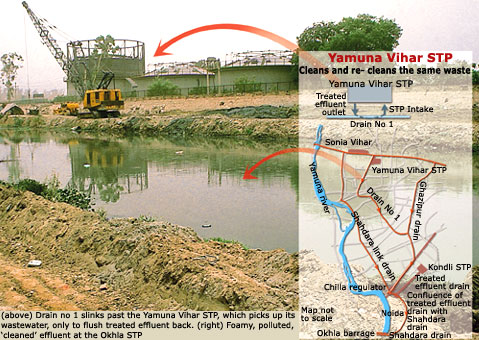What to do?
 Seventeen sewage treatment plants, 10 common effluent treatment plants, drains, pipes, low cost toilets, and thousands displaced in the name of river cleaning. But little impact. Why? That is what needs to be understood so that future policy can be built learning from past failures. Otherwise, there will be more money and pollution down the drain.
Seventeen sewage treatment plants, 10 common effluent treatment plants, drains, pipes, low cost toilets, and thousands displaced in the name of river cleaning. But little impact. Why? That is what needs to be understood so that future policy can be built learning from past failures. Otherwise, there will be more money and pollution down the drain.
The simplest answer to this riddle is that sewage treatment capacity has not kept in step with population and waste growth. This sewage-infrastructure approach is a game of catch that misses the point. Fact is that, officially, Delhi has an installed capacity to treat between 60-80 per cent of the domestic waste it generates. But the river still receives huge volumes of untreated and dirty effluents. Why?
built but not used: The fact is that the existing infrastructure to treat sewage remains grossly under-utilised. cpcb itself has revealed in a 2004 report that 13 out of the 17 stp s are underutilised; one of them does not receive any sewage.
The report indicates that about 73 per cent of Delhi's stps are functioning below design capacity, whereas 7 per cent are lying defunct. And just as some plants do not get sewage at all, others get too much and so cannot function efficiently! (See graph: Built but useless).
treated and not treated: The gap between treated and untreated sewage is underestimated. Only 1,470 mld of sewage is actually treated in the 17 stps, less than 40 per cent of the wastewater that flows into the river. It is no wonder, therefore, that the river remains polluted.
where there is an stp, there is no sewage: Drains to channelise sewage to the treatment plants exist, but do not function. The problem is that the djb has been trying to repair these sewers unsuccessfully over the past 10 years. Drain cleaning has become an exercise in perpetuity and futility.
where there is sewage, there is no stp: The location of stps is decided on the basis of land availability and not pollution management or even sewage management. So, Delhi's stps are invariably built in areas where the sewage needs to be transported long distances for treatment. In the case of its largest stp, the transportation of waste costs more than cleaning it up. But more importantly, Delhi has to depend on a sewerage network of 5,600 km to convey its wastewater to treatment facilities. The network needs a lot of repair, thereby turning sewage-sourcing into a costly and inefficient problem.
where there is sewage, it is
"illegal': But it is also the case that drains that can transport sewage do not exist at all, because there are settlements are not connected to the sewage system at all.
Almost 50 per cent of Delhi generates
Related Content
- Order of the National Green Tribunal regarding discharge of wastewater by the municipality of Belpahar on a farmers land, Jharsuguda, Odisha, 15/05/2025
- Order of the Supreme Court on the matter of felling of trees in and around Taj Trapezium Zone (TTZ), Agra, Uttar Pradesh, 07/05/2025
- UN World Water Development Report 2025
- Interconnected disaster risks: Turning over a new leaf (2025 report)
- What is the Missing Ingredient? The German Agriculture and Food Strategy for Africa 2025
- Order of the National Green Tribunal regarding supply of safe and clean drinking water to areas affected by Guillain Barre Syndrome (GBS) disease, Pune, Maharashtra, 06/03/2025
